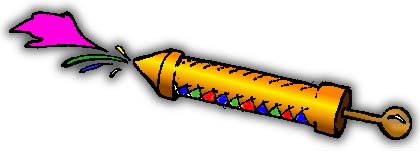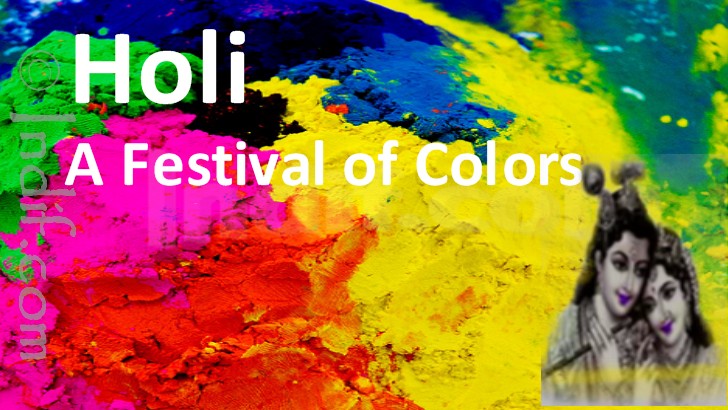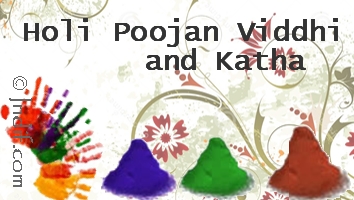![]()
On the fifth day of the dark half of Phalgun the feast of Color is celebrated. The festival marks the end of the year according to the Indian calendar, and the spirit of festivity is alive in every Hindu household. It is celebrated throughout India in early spring with cheer and gaiety. Holi comes when the cold winter months give way to summer. It takes place over two days around late February or March on a Poornima (or Pooranmashi) Full Moon as per the Hindu calendar. On the first day, a bonfire is lit at night to signify the burning of Holika. On the second day, known as Dhulandi, people go around until afternoon throwing colors at each other and meet and have fun.
Rituals and Customs :
Holi is spread out over two days (it used to be five, and in some places it is longer).On the evening of the first day of Holi, a public bonfire is held, commemorating the burning of Holika. Traditionally, Hindu boys spend the weeks prior to Holi combing the neighborhood for any waste wood they can find for the bonfire. The fire is lit sometime between 10 PM and midnight (at the rising of the moon), not generally in an orderly fashion.
Everyone gathers in the street for the event, and the air rings with shouts, catcalls, curses and general mayhem.
The central ritual of Holi is the throwing and applying of colored water and powders on friends and family, which gives the holiday its common name "Festival of Colors." This ritual is said to be based on the above story of Krishna and Radha as well as on Krishna's playful splashing of the maids with water, but most of all it celebrates the coming of spring with all its beautiful colors and vibrant life.
Mythological Significance :
Hiranyakashipu was the king of demons, and
he had been granted a boon by Brahma, which made
it almost impossible for him to be killed. The
boon was due to his long penance, after which he
had demanded that he not be killed 'during day
or night; inside the home or outside; not on
earth or on sky, neither by a man nor an
animal'. Consequently, he grew arrogant, and
attacked the Heavens and Earth. He demanded that
people stop worshipping gods and start praying
to him. But his own son, Prahlad, was a devotee
of Lord Vishnu. In spite of several threats from
Hiranyakashipu, Prahlad continued offering
prayers to Lord Vishnu. He was poisoned but the
poison turned to nectar in his mouth. He was
ordered to be trampled by elephants yet remained
unharmed. He was put in a room with hungry,
poisonous snakes and still survived. All of
Hiranyakashipu's attempts at killing him failed.
Ultimately he ordered young Prahlad to sit on a
pyre on the lap of his sister Holika, who could
not die by fire by virtue of a shawl which would
prevent fire affecting the person wearing it.
Prahlad readily accepted his father's orders,
and prayed to Vishnu to keep him safe. When the
fire started, everyone watched in amazement as
the shawl flew from Holika, who, then was burnt
to death, while Prahlad survived without a scar
to show for it, after the shawl moved on to
cover him. The burning of Holika is celebrated
as Holi.
According to another story,
Dhundha, the witch, or female demon, used to
harass small children. By lighting big fires it
is believed that she gets frightened and is
driven out of the village. Today the custom goes
on of making big bonfires in every lane of
cities and villages. In this way a huge amount
of firewood and much needed fuel is destroyed.
For this purpose children consider it their
right to collect wood from every imaginable
source. This in turn can easily lead to quarrels
and fights.
This feast is also known as
"kamdahan" (the burning of lust), or
"Madandahan" (the burning of Madan). As the
story goes, m order to destroy the demon
Tarkasur, the gods thought that only the son of
Shankar would have the needed power. But Shankar
was lost in meditation, not at all interested in
marriage or sexual pleasure. As Shankar was
deeply engrossed in his penance, the gods sent
Madan to tempt him. Madan tried to draw
Shankar's attention towards Parvati. Then
Shankar became angry and opening his third eye
on his forehead, he cast a fiery look on Madan
and reduced him to ashes.
Regional Celebrations :
Each area celebrates Holi differently; the Bhil tribesmen of western Madhya Pradesh, who've retained many of their pre-Hindu customs, celebrate holi in a unique way. In rural Maharashtra State, where the festival is known as Rangapanchami it is celebrated with dancing and singing. In the towns of Rajasthan — especially Jaisalmer — the music's great, and clouds of pink, green, and turquoise powder fill the air. The grounds of Jaisalmer's Mandir Palace are turned into chaos, with dances, folk songs, and colored-powder confusion.









